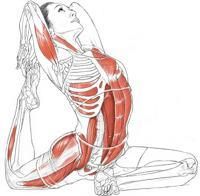
The exercise style of restorative yoga encourages deep relaxation. This style allows you to feel calmer through the passive and slow movements. Props are used to support different parts of the body while you do this type. Props can be used to prevent overextension of joints and muscles. They also help to stop the parasympathetic nervous systems from taking control, which can lead to pain. One example of a restorative posture is the crown chakra.
The easiest pose to try at home is the shimmy hips. Simply align your shoulders by bringing your palms to the top. Deepen your breath, then exhale. For extra support, you could also place a bolster or pillow underneath your lower back. This pose is very beneficial for those who suffer from stiff or sore necks. This pose can reduce pain and improve your well-being.

Another restorative posture is the seated one. To do this, you will need to sit near a wall and elevate your legs towards it. Take a deep, relaxing breath and relax your body. You can hold this position for as little as five to ten minutes or as long you like. Alternate between sitting and standing. To provide extra support if you are unable to remain in a seated position, a blanket or bolster can be used.
Restorative yoga poses can be challenging for many people. Props are helpful in helping you find the right posture and to focus on your breath. They can help you experience a state that is similar to meditation. For people suffering from chronic pain, back problems, or joint problems, restorative postures can be very beneficial. The benefits of these exercises are vast, and they are well worth your time. You will be amazed at the difference in your calmness and relaxation once you start using these techniques.
You can relieve stress from a long working day by doing restorative poses of yoga. They are also a great way to relax after a hectic day. These poses can either be done in a group, on your own or anywhere you want. Regardless of your preferred style, restorative poses can be a great way to unwind after a long day. And since they're not meditative, they don't require any specific physical effort.

Restorative poses are the perfect way to help your body and mind relax. These poses allow your body to relax and heal from stress and diseases by allowing it to open up and reset. They can also be a great way for your body to feel more flexible. If you're looking for a quality yoga class, look for a course that offers restorative poses. These poses will help you feel better and improve your overall health.
FAQ
What should my weight be for my age and height? BMI chart & calculator
The best way to determine how much weight you need to lose is to use a body mass index (BMI) calculator. A healthy BMI range should be between 18.5 and 24,000. You should lose about 10 pounds each month if you are trying to lose weight. Enter your height and weight to calculate your BMI.
This BMI chart shows you if it is possible to identify if you are either overweight or obese.
How often should I exercise
Exercise is essential for maintaining a healthy lifestyle. There is no time limit on how much you should exercise. Finding something you enjoy is key. Stick with it.
If you are working out three times a weeks, aim to do 20-30 minute of moderate intensity. Moderate intensity means that your muscles will continue to work hard even after you finish. This type works out burns around 300 calories.
Walking is a great option if you are a keen walker. You can do 10-minute walks four days per week. Walking is low impact and easy on your joints.
If you'd rather run, try jogging for 15 minutes three times a week. Running can help you burn calories and to tone your muscles.
Begin slowly if your are not used to working out. You can start with only 5 minutes per week of cardio. Gradually increase duration until you achieve your goal.
How do you get enough vitamins?
You can obtain most of your daily requirement through diet alone. Supplements can be helpful if you are lacking in any one vitamin. You can take a multivitamin supplement that contains all the vitamins you need. You can also purchase individual vitamins at your local drugstore.
Talk to your doctor about the best foods for vitamins if you're concerned about not getting enough nutrients. For example, dark green leafy vegetables such as spinach, broccoli, kale, collard greens, turnip greens, mustard greens, bok choy, romaine lettuce, arugula, and Swiss chard are rich in vitamins K and E. Other good sources include oranges, tomatoes, strawberries, cantaloupe, carrots, sweet potatoes, pumpkin, and squash.
Ask your doctor if there is any doubt about how much vitamin you should be taking. The doctor will determine the proper dosage based upon your medical history as well as your current health.
Is it possible to have a weak immune system due to being cold?
Cold weather can cause a decline in your immune system. Your body produces fewer white blood cell which fight infection. But, cold makes you feel better. Your brain releases endorphins that reduce pain.
Statistics
- In both adults and children, the intake of free sugars should be reduced to less than 10% of total energy intake. (who.int)
- The Dietary Guidelines for Americans recommend keeping added sugar intake below 10% of your daily calorie intake, while the World Health Organization recommends slashing added sugars to 5% or less of your daily calories for optimal health (59Trusted (healthline.com)
- According to the 2020 Dietary Guidelines for Americans, a balanced diet high in fruits and vegetables, lean protein, low-fat dairy and whole grains is needed for optimal energy. (mayoclinichealthsystem.org)
- WHO recommends consuming less than 5% of total energy intake for additional health benefits. (who.int)
External Links
How To
What does the word "vitamin" mean?
Vitamins are organic compounds that can be found in foods. Vitamins allow us to absorb nutrients from food. Vitamins cannot be produced by the body. They must be acquired from food.
There are two types vitamins: water soluble or fat soluble. Water-soluble vitamins dissolve quickly in water. Examples include vitamin C,B1 (thiamine), B2 (riboflavin), B3 (niacin), B6 (pyridoxine), folic acid, biotin, pantothenic acid, and choline. Fat-soluble vitamins are stored in the liver, fatty tissue and kidneys. You can find vitamin D, E K, A, beta carotene, and other fat-soluble vitamins.
Vitamins can be classified by their biological activity. There are eight major categories of vitamins.
-
A - Vital for normal growth and maintaining good health.
-
C - vital for proper nerve function, and energy production.
-
D - essential for healthy bones, teeth, and gums.
-
E - needed for good vision and reproduction.
-
K – Required for healthy nerves & muscles.
-
P - vital for building strong bones andteeth.
-
Q - aids digestion, absorption and absorption iron
-
R - Required for red blood cell production
The recommended daily intake (RDA), of vitamins varies with age, gender and physical condition. The U.S. Food and Drug Administration sets RDA values.
For adults 19 years and over, the RDA of vitamin A is 400mg per day. However, pregnant women need 600 micrograms per day because it is important for fetal development. Children ages 1-8 require 900 micrograms per day. Babies under one-year old require 700 mg per day. Between 9 and 12 years of age, however, this drops to 500 mg per day.
Children aged 1-18 years need 800 micrograms daily, while children overweight require 1000 micrograms per days. Children who are severely obese or underweight will need 1200 micrograms each day.
Children between 4 and 8 years old with anemia will need 2200 micrograms daily of vitamin C.
2000 micrograms daily is required for adults over 50 to maintain their general health. Due to their increased nutrient needs, pregnant and breastfeeding women need 3000 micrograms daily.
Adults over 70 need 1500 micrograms daily, as they lose 10% of their muscle every ten years.
Women who are pregnant or lactating need more than the RDA. Pregnant women require 4000 micrograms daily during pregnancy, and 2500 micrograms every day after birth. Breastfeeding mothers require 5000 micrograms daily when breast milk production is occurring.